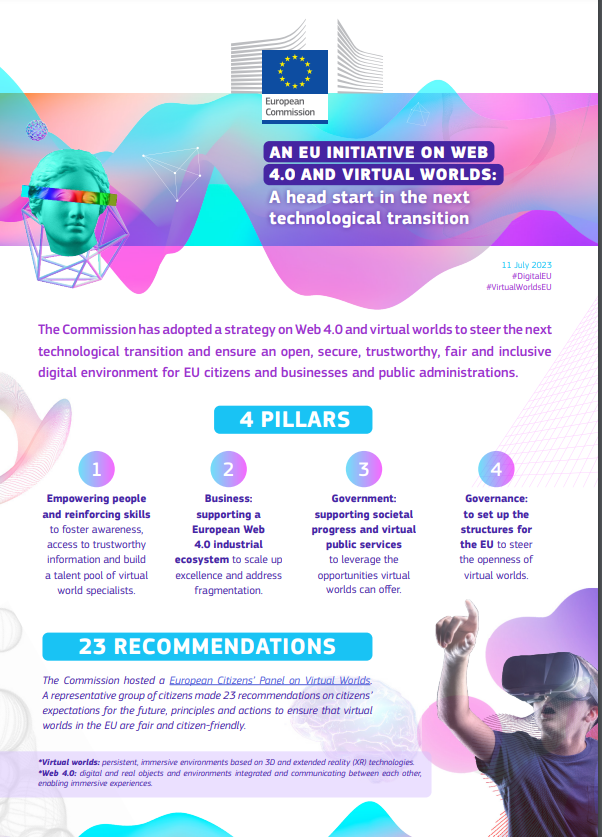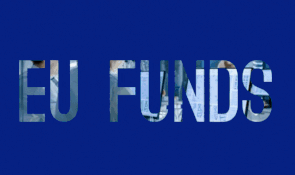Brussels,
THE NEW FRONTIERS
Virtual Worlds
In July 2923, the Commission has adopted a new strategy for Web 4.0 and virtual worlds, setting the course for the next technological transition. This strategy ensures an open, secure, trustworthy, fair, and inclusive digital environment for EU citizens, businesses, and public administrations.
As the internet rapidly evolves, the forthcoming generation, Web 4.0, is on the horizon. Building on the features of Web 3.0, which emphasizes openness, decentralization, and user empowerment, Web 4.0 will further integrate digital and real objects and environments, enabling enhanced interactions between humans and machines.
The EU's economy beyond 2030 places digitalization as a key driver, with Web 4.0 as a transformative technological shift. This interconnected, intelligent, and immersive world is projected to expand the global virtual worlds market from €27 billion in 2022 to over €800 billion by 2030.
The impact of virtual worlds will shape societal dynamics, offering opportunities and posing challenges. The new strategy envisions a Web 4.0 and virtual worlds aligned with EU values, ensuring people's rights and fostering thriving European businesses.
As the internet rapidly evolves, the forthcoming generation, Web 4.0, is on the horizon. Building on the features of Web 3.0, which emphasizes openness, decentralization, and user empowerment, Web 4.0 will further integrate digital and real objects and environments, enabling enhanced interactions between humans and machines.
The EU's economy beyond 2030 places digitalization as a key driver, with Web 4.0 as a transformative technological shift. This interconnected, intelligent, and immersive world is projected to expand the global virtual worlds market from €27 billion in 2022 to over €800 billion by 2030.
The impact of virtual worlds will shape societal dynamics, offering opportunities and posing challenges. The new strategy envisions a Web 4.0 and virtual worlds aligned with EU values, ensuring people's rights and fostering thriving European businesses.
The EU Strategy
|
Here's a breakdown of the strategy's key points:
1. Alignment with Digital Decade Objectives: The strategy is in line with the 2030 objectives of the Digital Decade policy programme, focusing on digitalization pillars: skills, business, and public services. The fourth pillar, infrastructures, is addressed through the Commission's connectivity package and broader efforts in computing, cloud, and edge capacities. The strategy also emphasizes openness and global governance of virtual worlds and Web 4.0 as specific action areas. 2. Empowering People and Reinforcing Skills: - Promoting Guiding Principles: By the end of 2023, the Commission will promote guiding principles for virtual worlds set by the Citizens' Panel. - Citizen Toolbox: The Commission will develop a 'Citizen toolbox' by Q1 2024 to provide guidance to the general public. - Talent Pipeline: Collaboration with Member States to establish a talent pipeline for virtual world specialists. - Skills Development: Supporting skills development, including for women and girls, through Digital Europe Programme projects, and for digital content creators through the Creative Europe programme. |
3. Business Support:
- European Web 4.0 Industrial Ecosystem: Aiming to establish a European ecosystem for Web 4.0 and virtual worlds.
- Proposed Partnership on Virtual Worlds: Suggesting a candidate Partnership under Horizon Europe to enhance research and develop an industrial roadmap.
- Innovation Support: Assisting EU creators and media companies with testing new creation tools, fostering developer-industrial user collaborations, and developing regulatory sandboxes.
4. Government Involvement:
- Leveraging Virtual Public Services: Utilizing virtual worlds for societal progress and public services.
- Major Initiatives: Investing in initiatives like Destination Earth, Local Digital Twins, and European Digital Twin of the Ocean.
- New Public Flagships: Launching "CitiVerse" for urban planning and management, and a European Virtual Human Twin for clinical decisions and personal treatment.
5. Shaping Global Standards:
- Open and Interoperable Virtual Worlds: Ensuring dominance is not held by a few major players.
- Engagement and Promotion: Engaging with global internet governance stakeholders and promoting Web 4.0 standards that align with EU values.
This strategy aims to create an environment of innovation, skills development, business growth, and global cooperation for the evolution of virtual worlds and Web 4.0.
- European Web 4.0 Industrial Ecosystem: Aiming to establish a European ecosystem for Web 4.0 and virtual worlds.
- Proposed Partnership on Virtual Worlds: Suggesting a candidate Partnership under Horizon Europe to enhance research and develop an industrial roadmap.
- Innovation Support: Assisting EU creators and media companies with testing new creation tools, fostering developer-industrial user collaborations, and developing regulatory sandboxes.
4. Government Involvement:
- Leveraging Virtual Public Services: Utilizing virtual worlds for societal progress and public services.
- Major Initiatives: Investing in initiatives like Destination Earth, Local Digital Twins, and European Digital Twin of the Ocean.
- New Public Flagships: Launching "CitiVerse" for urban planning and management, and a European Virtual Human Twin for clinical decisions and personal treatment.
5. Shaping Global Standards:
- Open and Interoperable Virtual Worlds: Ensuring dominance is not held by a few major players.
- Engagement and Promotion: Engaging with global internet governance stakeholders and promoting Web 4.0 standards that align with EU values.
This strategy aims to create an environment of innovation, skills development, business growth, and global cooperation for the evolution of virtual worlds and Web 4.0.
EU Funding Programmes
HaDEA, the European Health and Digital Executive Agency is managing projects developing virtual world technologies to be applied in different fields. Discover the projects and their contributions below:




